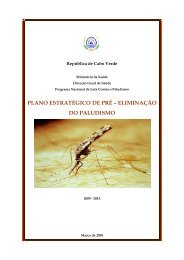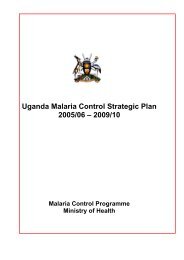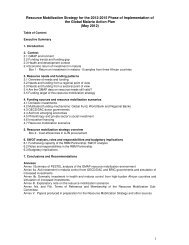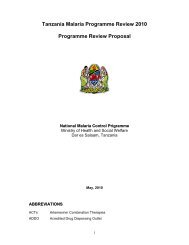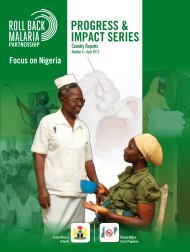Namibia Malaria Programme Performance Review - Roll Back ...
Namibia Malaria Programme Performance Review - Roll Back ...
Namibia Malaria Programme Performance Review - Roll Back ...
You also want an ePaper? Increase the reach of your titles
YUMPU automatically turns print PDFs into web optimized ePapers that Google loves.
Aide Mémoire<br />
NAMibiA MAlAriA ProgrAM PerforMANce review<br />
1. PurPose<br />
The National Vector-borne Diseases Control <strong>Programme</strong> (NDVCP) within the Directorate of Special <strong>Programme</strong>s (DSP) in<br />
the Ministry of Health and Social Services (MoHSS), in collaboration with key partners, conducted a <strong>Malaria</strong> <strong>Programme</strong><br />
performance <strong>Review</strong> (MPR) between May and July 2010. The aim of the MPR was to review the programme and redefine<br />
its strategic direction to ensure further reduction of malaria in <strong>Namibia</strong>, particularly in light of the national goal of malaria<br />
elimination. The major findings and key actions arising from the MPR are summarized in this aide memoire. The aide<br />
memoire is not a memorandum of understanding and it is not legally binding. Rather, it is a statement of the commitment of<br />
the Government of <strong>Namibia</strong> and its health development partners, to work together for the implementation and follow up of<br />
the key recommendations of the malaria programme review.<br />
2. bAckgrouNd<br />
Given the observed decline in malaria incidence and deaths in all malaria risk areas of <strong>Namibia</strong> and improving coverage of<br />
interventions, DSP in collaboration with the Ministry of Defense, World Health Organization (WHO), United Nations Children’s<br />
Fund (UNICEF), Southern Africa <strong>Malaria</strong> Elimination Support Team (SAMEST), Society For Family Health (SFH), and<br />
Anglican Diocese/Nets for Life, <strong>Namibia</strong> Institure of Pathology (NIP) and Development Aid from People to People (DAPP)<br />
supported the NDVCP in conducting this comprehensive review of the National <strong>Malaria</strong> Control Program.<br />
The specific objectives of the MPR were to:<br />
• <strong>Review</strong> the epidemiology of malaria<br />
• <strong>Review</strong> the program interventions by thematic service area<br />
• Measure progress towards 2010 <strong>Roll</strong> <strong>Back</strong> <strong>Malaria</strong> (RBM) and 2015 Millennium Development Goals goals and targets.<br />
• <strong>Review</strong> program delivery systems, performance and challenges within the context of the health system and the national<br />
development agenda.<br />
• Define the next steps and program targets in the context of malaria elimination.<br />
Aide Memoire: <strong>Malaria</strong> Program <strong>Performance</strong> <strong>Review</strong> 1
3. objectives ANd AchieveMeNts of the 2003-2007<br />
MAlAriA strAtegic PlAN<br />
The expired <strong>Malaria</strong> Strategic Plan 2003-2007 established the goal of reducing malaria morbidity and mortality to such an<br />
extent that it would no longer be a major public health problem by 2007; specifically, it aimed to reduce malaria morbidity and<br />
mortality by 35 percent respectively by the year 2007 as compared to the year 2000. The strategy’s activities were organized<br />
according to eight service delivery areas:<br />
• Improved malaria disease management<br />
• Epidemic preparedness and response<br />
• Vector control<br />
• Surveillance monitoring and evaluation<br />
• Operational research; advocacy and community education<br />
• <strong>Programme</strong> management.<br />
4. key fiNdiNgs ANd recoMMeNdAtioNs<br />
4.1 <strong>Malaria</strong> Epidemiology<br />
2 Aide Memoire: <strong>Malaria</strong> Program <strong>Performance</strong> <strong>Review</strong><br />
<strong>Malaria</strong> transmission occurs in nine regions (22 districts) of <strong>Namibia</strong>. 1.2 million people (65 percent of the<br />
population) lives in malaria transmission areas. However, the intensity of malaria transmission is generally low<br />
(except in Caprivi and Kavango regions); endemicity is highest in the north-eastern part of the country (along the<br />
borders with Angola and Zambia), and decreases towards the west, south west and east.<br />
A total of 97% of malaria cases are due to infection with Plasmodium falciparum, while the remaining 3% are<br />
attributable to the remaining 3 species (P. Vivax, P. Ovale and P. <strong>Malaria</strong>e). The principal malaria vector is An.<br />
arabiensis. Recent studies at vector sentinel sites confirm that the previous primary vectors A. gambiae and A.<br />
funestus have been eliminated.<br />
According to data collected through the weekly malaria surveillance systems and the monthly Health and<br />
Management Information System (HMIS), there has been a sustained impact on malaria disease burden,<br />
demonstrated through the reduction in the incidence of malaria cases. In 2008, there were:<br />
- A total of 128,531(62/1,000) reported outpatient malaria cases compared to 583,267 (318.7/1000) cases in 2001<br />
- A total of 5,233 (0.9/1000) inpatient cases were reported in 2008, down from 41,117 (22.95/1000) inpatient<br />
cases in 2001 and<br />
- A total of 199 deaths were reported in 2008, compared to 1,681 in 2001.<br />
Trends in outpatient cases, inpatient cases, and deaths exhibit a decline of 78 percent, 87 percent, and 88 percent<br />
respectively between 2001 and 2008; however, these trends need to be interpreted in the context of changes in<br />
case definitions since the introduction of parasitological confirmation of cases, as well as incompleteness of the<br />
HIS and weekly surveillance systems.<br />
Since 2002, a climate-based malaria risk stratification has been in use; this is now outdated and is currently being<br />
updated with a transmission risk mapping at constituency level, based on epidemiological modelling, combining<br />
the distribution of human population, malaria infection prevalence, malaria case incidence data and remotely<br />
sensed climate data.
Action Points<br />
Strengthen trend monitoring and malaria case mapping to track temporal and geographical variations to inform action for<br />
both local and imported cases<br />
In areas with zero deaths, implement strategies/interventions to sustain zero death<br />
In areas with more than 1 death, implement strategies/interventions to reduce mortality to to zero by 2011.<br />
In areas currently classified as malaria free, implement strategies/interventions to sustain zero transmission.<br />
Co-relate malaria data with meteorological data for the past decades to identify association and forecast epidemics and<br />
disease trends<br />
4.2 <strong>Malaria</strong> communication: Advocacy, information Education<br />
communication/ Behavior change communication (iEc/Bcc) and<br />
community Mobilization<br />
Although malaria is a priority public health program in the MoHSS, high level advocacy has not been adequate to<br />
influence national, regional and district leadership to sustain the scale up of malaria control. World <strong>Malaria</strong> Days<br />
and SADC <strong>Malaria</strong> Awareness Days have been commemorated since 2007; national awareness days have also<br />
been established.<br />
There is extensive movement of people between the northern endemic areas and the malaria free southern<br />
regions, and these increases significantly during the holiday seasons. <strong>Namibia</strong> shares long, porous borders with<br />
Angola, Zambia and Botswana, were ethnic population are divided on either side of the border and also attracts<br />
tourists from Europe and neighboring endemic countries on the northern and eastern borders, resulting in heavy<br />
movement across the border for trade and social reasons, as well as for health services in <strong>Namibia</strong>. This further<br />
contributes to the risk for importation of malaria cases between areas of varying transmission potential.<br />
IEC/BCC appears to be the weakest programmatic area with insufficient messaging and IEC materials. The NDVCP<br />
does not have an IEC/BCC focal point to ensure coordination of malaria IEC activities. However, a national <strong>Malaria</strong><br />
Communication and Advocacy Strategy was developed in 2009. Moreover, there is an existing communication task<br />
force on malaria IEC and community-based organizations such as SFH, Nets for Life and Development aid for People<br />
to People (DAPP) who contributed to malaria BCC in both urban and rural areas. Although knowledge about malaria is<br />
high, Insecticides treated nets (ITNs) use and treatment seeking behavior remains low. In addition, there is no community<br />
based malaria programming, and community health workers’ involvement in malaria programming is weak.<br />
Action Points<br />
Conduct/commission studies on community perceptions towards different interventions and orient the production of needed<br />
IEC materials.<br />
Involve community liaison officers at regional and constituency levels in community mobilization for malaria activities.<br />
Train malaria community health workers to cover hard to reach areas and support active surveillance for malaria preelimination.<br />
4.3 Entomology and Vector control<br />
<strong>Namibia</strong> combines indoor residual spraying (IRS), the use of long-lasting insecticide treated nets (LLINs), and<br />
larviciding as key vector control strategies. Entomological surveillance is conducted in all 13 regions at 16 vector<br />
sentinel sites. Anopheles arabiensis – which still bites both indoors and outdoors - has a wide variety of breeding<br />
sites in all malaria transmission areas. Vector susceptibility studies using WHO standard methods showed that<br />
DDT (the main insecticide) and Deltamethrine have 100% mortality at 24 hours post exposure.<br />
Aide Memoire: <strong>Malaria</strong> Program <strong>Performance</strong> <strong>Review</strong> 3
4 Aide Memoire: <strong>Malaria</strong> Program <strong>Performance</strong> <strong>Review</strong><br />
The NDVCP has a strong central vector control technical team, which has built capacity at regional and district<br />
levels. Regional and district IRS managers – supported by the national team - conduct annual pre-season trainings<br />
for the spray teams on spraying techniques, safety operation and handling of spraying equipment. <strong>Namibia</strong><br />
also conducts targeted winter larviciding during the dry season at vector breeding sites identified by entomological<br />
sampling in the north-east.<br />
Annual IRS operational coverage has generally remained above 80 percent since 2005. The quality of the IRS<br />
spraying is assessed annually through bioassay tests. The IRS operations faces operational challenges such as<br />
lack of buffer stocks, limited transport fleet and slow payment of spray operators by the regions, and refusals by<br />
some communities to spray their houses.<br />
Between 2005 and 2009 1,076,538 LLINs were distributed to children under five and pregnant women. The<br />
programme has not begun the rollout of a recent policy of universal coverage with one LLIN per two people in<br />
areas of moderate transmission. The 2009 MIS showed that LLINs usage among children under five years and<br />
pregnant women was 34.0 percent and 25.9 percent, respectively.<br />
Action Points<br />
Implement universal coverage with IRS in Caprivi, Kavango, Ohangwena, Oshana, Omusati, and Oshikoto, in identified<br />
residual active malaria foci (hot spots) in epidemic prone areas, and in identified new active foci in areas currently classified<br />
as malaria free.<br />
Distribute (free of charge) 650,000 LLINs to achieve universal coverage in Caprivi, Kavango, Ohangwena, Oshana, Omusati,<br />
and Oshikoto.<br />
Provide additional 13 vehicles and 12 tractors for IRS supervision and for transporting spray operators, respectively.<br />
Build capacity for entomological surveillance and insecticide resistance monitoring at sentinel sites.<br />
Establish regional entomology teams to collect entomology data from sentinel sites<br />
4.4. Epidemic-Emergency Preparedness and Response<br />
Historically, areas in Northern <strong>Namibia</strong> have been subject to malaria epidemics. Today, all districts appear to<br />
have low unstable transmission and are at high risk of epidemics. A malaria epidemic preparedness guideline<br />
has been in place since 2005 and has widely been distributed. However, malaria epidemic preparedness plans<br />
are not updated annually at all levels. Weekly epidemic surveillance from all health facilities is maintained during<br />
the malaria transmission season (October to June). Epidemic thresholds were developed in 2003 using five year<br />
average means, but these appear to be too complex for field use and are not being updated annually. A record of<br />
epidemics, by locality and month of occurrence, and the associated number of cases and deaths reported is not<br />
kept. The weekly surveillance system is not being analyzed to detect minor malaria outbreaks.<br />
Action Points<br />
Designate a malaria Epidemic Preparedness and Response (EPR) focal person within the NDVCP<br />
Update the malaria EPR policy and guidelines, as well as threshold charts and other surveillance tools.<br />
4.5 <strong>Malaria</strong> Diagnosis and treatment<br />
Diagnosis and treatment services are provided free of charge at primary, secondary and tertiary care facilities;<br />
Artemisinin based Combination Therapy (ACT) is the first line anti-malarial medicine for treatment of uncomplicated<br />
malaria. Primary diagnosis is based on RDT HRP-2/microscopy testing, with the exception of children under five<br />
and during peak transmission season (according to the existing policy).
District pharmacies and all health facilities are well supplied with RDTs, ACTs and pre-referral Quinine with stock<br />
outs reported in very few facilities. <strong>Namibia</strong> Institute of Pathology (NIP) laboratories provide access to microscopy<br />
diagnosis and other investigations in all hospitals. Since 2009, the policy on Integrated Management of Childhood<br />
Illnesses (IMCI) has recommended testing for malaria in cases of fever in under fives, before treating. There is also<br />
a well- established national pharmacovigilance system for notification and investigation of drug adverse reactions.<br />
The malaria policy is not up to date. About 50 percent of the suspected malaria cases are treated despite a<br />
negative test result, or based on clinical assessment. The quality of malaria diagnosis with RDT and microscopy<br />
is not monitored. There is still inadequate training and supervision on malaria case management due to rapid staff<br />
turnover and rotation, lack of funds for the annual cascade training, as well as the fact that some health facilities<br />
are managed entirely by one health worker (especially at clinic level) who is not able to abandon the facility for<br />
extended periods of time to attend trainings. There are no job aids, clinical algorithms and wall charts to support<br />
health workers diagnosis and treatment. In addition, there is lack of access to diagnosis and treatment services in<br />
hard-to reach areas. There is no malaria mortality notification for investigation and improving the timely referral and<br />
management of severe malaria.<br />
Action Points<br />
Update malaria policy guidelines to reflect new recommendations on diagnosis and the new developments guiding malaria<br />
treatments.<br />
Establish malaria laboratory reference centers through NIP; develop and implement an internal quality assurance system for<br />
malaria diagnosis and provide malaria PCR support.<br />
Increase access to early diagnosis and treatment at community level, especially in the hard to reach areas, through<br />
community health workers which may require deregulation of use of ACTs and RDTs.<br />
Build capacity on malaria case management at all levels and provide additional support to supportive supervision.<br />
4.6 <strong>Malaria</strong> in Pregnancy<br />
The national malaria policy does not specifically recommend routine screening for malaria amongst pregnant<br />
females attending ANC. However, all patients attending ANC have full blood counts routinely done, which could<br />
be an opportunity for malaria screening. In addition, in areas previously highly endemic, two doses of Intermittent<br />
Preventive Treatment are currently recommended.<br />
Action Points<br />
Develop/update a malaria in pregnancy policy and guidelines<br />
Strengthen collaboration with Safe Motherhood and Reproductive Health programs on scaling up malaria in pregnancy<br />
interventions.<br />
4.7 surveillance, Monitoring and Evaluation and operational Research<br />
There are three information systems to capture malaria surveillance data in <strong>Namibia</strong>. Health Information System<br />
(HIS) is the overall standardized health monitoring system; it records and reports on clinical malaria in outpatients<br />
and inpatient malaria departments, including inpatient deaths, disaggregating by age group and gender. A malaria<br />
weekly surveillance system is in place in the 9 malaria endemic regions. This system reports malaria cases on a<br />
weekly basis for seven months each year (November to June) and is mainly used to detect unusual trends and<br />
initiate appropriate action. <strong>Namibia</strong> also collects malaria data through the Integrated Disease Surveillance System<br />
(IDSR) which includes malaria as one of the notifiable diseases, although this system is at an early stage of<br />
development.<br />
Aide Memoire: <strong>Malaria</strong> Program <strong>Performance</strong> <strong>Review</strong> 5
6 Aide Memoire: <strong>Malaria</strong> Program <strong>Performance</strong> <strong>Review</strong><br />
The malaria weekly surveillance system is able to generate the core malaria morbidity indicators required by the<br />
programme, while the HIS system suffers from lack of timeliness and completeness. The data collection tools for<br />
the weekly surveillance system are not standardized across regions and this data is not analyzed at the concerned<br />
facilities using the threshold charts. The NDVCP also collects information on other activities in health facilities<br />
through separate forms for LLIN and IPT delivery.<br />
As <strong>Namibia</strong> reduces the malaria burden, more robust surveillance systems are required to allow mapping and<br />
location of malaria infections and case tracking. The NVDCP has identified annual bio-assay studies, biennial<br />
vector susceptibility studies, and biennial therapeutic efficacy studies as priority areas for operational research.<br />
There are no known local research teams that focus on malaria and collaboration with local and international<br />
partners in the area of research is quite limited. The University of <strong>Namibia</strong> (UNAM) laboratory has a fully equipped<br />
malaria research laboratory and is able to conduct molecular research work. The NVDCP has involved the National<br />
Institute of Pathology in antimalarial medicines resistance studies. Currently, <strong>Namibia</strong> does not have a national<br />
monitoring and evaluation plan.<br />
Action Points<br />
Develop a national monitoring and evaluation plan including standardized malaria case definitions and indicators and standardized<br />
malaria weekly and monthly data collection tools with linkage to HIS.<br />
Develop guidelines for case based notification and follow up investigation of each confirmed malaria case, and for contact<br />
tracing to eliminate the parasite for malaria free areas.<br />
Prioritize operational research areas and strengthen the partnership for research with University of <strong>Namibia</strong> and other<br />
international partners in the area of research.<br />
4.8 Policies, Guidelines, organization and Management<br />
The NVDCP is under the Directorate of Special <strong>Programme</strong>s (DSP), along with HIV/AIDS and Tuberculosis; its role<br />
has expanded to include formulating policies and guidelines, building capacity and supporting implementation from<br />
national level to regions, districts and health facilities.<br />
- At regional level, malaria is managed by different departments of the Primary Health Care Directorate supported<br />
by a part time malaria focal point.<br />
- At district level, malaria programme is managed by PHC nurses and environmental health officers.<br />
- At health centre and clinic level, there are nurses providing malaria diagnosis and case management as well<br />
as other routine health services delivery. However, health workers in health facilities are unable to devote<br />
enough time to malaria prevention education, and surveillance.<br />
- At community level, where there are currently limited malaria services, some NGOs reach households with<br />
community mobilization activities and LLIN distribution and hang-up their nets.<br />
As the malaria burden continues to decline, a larger, capacitated programme is necessary to sustain the gains<br />
made and move further to pre-elimination.<br />
The NVDCP has an integrated, comprehensive <strong>Malaria</strong> Policy which is accompanied by a <strong>Malaria</strong> Epidemic Preparedness<br />
and Response Plan, as well as an Integrated Vector Control Policy. Annual operational planning and<br />
activities have been guided by the National <strong>Malaria</strong> Strategic Plan 2003-2007. Annual malaria review and planning<br />
meetings are held with regions, districts and partners. However, no quarterly review and planning meetings are<br />
held to track implementation.<br />
The MoHSS, through the regional health departments, provides the bulk of the financing for the malaria programme,<br />
especially for IRS. The national malaria budget is integrated within other budget votes at the MoHSS, therefore
5 coNclusioN<br />
it is difficult to separate the malaria control costs and plan for sustainability; it is proposed that a special malaria<br />
sub-vote and budget be created in DSP and in the regions. The programme has been further supported in the last<br />
five years by funding from the Global Fund. Despite this support, significant shortfalls in the programme’s needs<br />
over the coming years remain.<br />
There is a strong inter-sectoral partnership with Ministries of Defense Health Services, Education, Tourism and<br />
Environment, as well as with NGOs (Society for Family Health, Development Aid from People to People (DAPP)<br />
and Anglican Church/Nets for Life). Strong partnerships exist with WHO, UNICEF and the Southern Africa<br />
<strong>Malaria</strong> Elimination Support Team which provide technical and planning support. <strong>Namibia</strong> has also prioritized the<br />
establishment of cross-border malaria control initiatives, cognizant of the need to collaborate with neighboring<br />
countries in controlling the transmission and importation of malaria in the border regions. Trans-Kunene <strong>Malaria</strong><br />
Initiative is under development and further collaboration along the Caprivi and Kazungula border with Zambia,<br />
Botswana, Angola and Zimbabwe is in the exploratory stages.<br />
Action Points<br />
Develop/update the 2010-2016 <strong>Malaria</strong> Strategic Plan in the context of the Millennium Development Goals, National<br />
Development Plans III and <strong>Namibia</strong> Vision 2030.<br />
Restructure the programme to respond to the new malaria programme needs with personnel<br />
Develop/update a comprehensive malaria policy document and guidelines<br />
Establish a national high level intersectoral malaria elimination task force and relevant technical subcommittees to advise<br />
and support the programme<br />
Secure additional financial resources to support universal coverage of malaria interventions including cross border initiatives<br />
from the government of <strong>Namibia</strong> including establishment of a malaria budget and vote.<br />
Lobby support and resources from NGOs , development partners and private sector to support universal coverage and<br />
cross border activities<br />
Implement border malaria programme with Angola, Zambia, Zimbabwe and Botswana<br />
The <strong>Namibia</strong> malaria control programme is performing well and has achieved a remarkable impact since 2005, as evidenced<br />
by low levels of transmission in many constituencies and villages. In the short term, the programme needs to move towards<br />
and sustain universal coverage in the 6 low to moderate transmission districts, and has potential to move towards pre<br />
elimination in low transmission districts of Omaheke, Kunene and Otjozondjupa in the long term. The four regions which<br />
are currently free of indigenous transmission still need robust surveillance to detect and effectively manage imported cases<br />
and outbreaks. The review urges the MoHSS and its key partners to consolidate this remarkable progress and success with<br />
strengthening of and restructuring of the programme to enable focus on reducing deaths by 2011 and local transmission to<br />
zero by 2020.<br />
This review concludes that with some reorientation and changes in policies, strategies, and program re-organization and<br />
additional financing, a move towards pre-elimination by 2012 and towards a vision of malaria free <strong>Namibia</strong> by 2020 is<br />
feasible.<br />
Aide Memoire: <strong>Malaria</strong> Program <strong>Performance</strong> <strong>Review</strong> 7
6. coMMitMeNt<br />
We, the Ministry of Health and Social Services of the Government of the Republic of <strong>Namibia</strong>, and health partners of the<br />
<strong>Malaria</strong> <strong>Programme</strong> in <strong>Namibia</strong>, re-commit ourselves to the implementation of the key action points recommended by this<br />
review towards acceleration and scaling up malaria interventions and cross-border implementation towards the ultimate goal<br />
of a malaria free <strong>Namibia</strong> by 2020.<br />
Signed on behalf of the Ministry of Health and Social Services, Government of <strong>Namibia</strong> and health development partners:<br />
_________________________<br />
Mr. Kahijoro Kahuure<br />
Permanent Secretary<br />
Ministry of Health and Social Services<br />
Republic of <strong>Namibia</strong><br />
_____________________________<br />
Dr. Magda Robalo<br />
Country Representative,<br />
World Health Organization<br />
<strong>Namibia</strong><br />
___________________________<br />
Mr. Ian Macleod<br />
United Nations Children’s Fund<br />
<strong>Namibia</strong><br />
In Windhoek on Monday the 17 th of January 2011<br />
8 Aide Memoire: <strong>Malaria</strong> Program <strong>Performance</strong> <strong>Review</strong>




